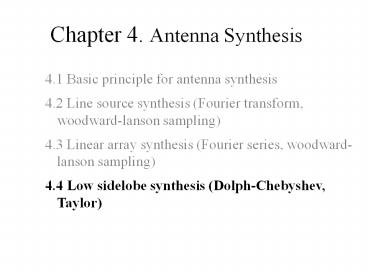Chapter 4. Antenna Synthesis - PowerPoint PPT Presentation
Title:
Chapter 4. Antenna Synthesis
Description:
Chapter 4. Antenna Synthesis 4.1 Basic principle for antenna synthesis 4.2 Line source synthesis (Fourier transform, woodward-lanson sampling) 4.3 Linear array ... – PowerPoint PPT presentation
Number of Views:936
Avg rating:3.0/5.0
Title: Chapter 4. Antenna Synthesis
1
Chapter 4. Antenna Synthesis
4.1 Basic principle for antenna synthesis 4.2
Line source synthesis (Fourier transform,
woodward-lanson sampling) 4.3 Linear array
synthesis (Fourier series, woodward-lanson
sampling) 4.4 Low sidelobe synthesis
(Dolph-Chebyshev, Taylor)
2
Synthesis Problems
Given affordable SLL, No. of elements, how to
synthesize?
Ideal case narrow beam, constant side-lobe
envelope
Approaches Dolph-Chebyshev, Taylor Line Source.
Secret behind to synthesize a polynomial like
pattern.
3
Dolph-Chebyshev Linear Array
The Chebyshev polynomials
Property used
4
Chebyshev Polyminals
5
Symmetrically Excited Array
, P odd
, P even
Property
is P-1 th polynomial of
Let
Choose appropriate to match the coefficients
to those in Chebyshev polynomial, we obtain,
6
Chebyshev Polynomial Example
7
Synthesis Standards
SLL-20log R (dB)
so
Optimum spacing,
Endfire
Broadside
, where
8
Beamwidth and Directivity
(broadside)
In general,
(endfire)
, where
An approximation for the broadside
Beambroadening factor
Directivity
9
Example No.1
Five element array (P5), -20dB Side-Lobe,
Half-Wavelength Spaced Dolph-Chebyshev Array
10
Synthesized Array Factor
11
Example No.2
Optimum Spaced 10-Element, -30dB Side
Lobe, Dolph-Chebyshev Endfire Array
12
Taylor Line Source Method
Transform
where a is a constant and,
So the pattern maximum is,
For the side-lobe region
Main beam region
13
Transformed Chebyshev Polynomial
14
Basic Properties of Zeros
Zeros of the transformed function in the
side-lobes are given by
For the main beam,
and
Introduce A so that,
For large N,
15
Selection of Constant a
a is selected so that the first zero location
remains fixed as N increases,
Then
The pattern should have the following format,
16
Ideal Pattern Factor
Normalizing the pattern to unity at x0,
(side lobes)
(main beam)
17
Realistic Pattern Factor
where
In format of w,
18
Woodward-Lawson Equivalent
for
The source current is
19
Beamwidth and Directivity
(ideal Taylor)
(realistic Taylor)
20
Example
A 10-Wavelength Taylor Line Source with 25 dB
side lobes and
21
Pattern and Current Source































